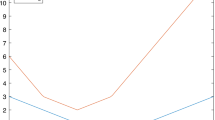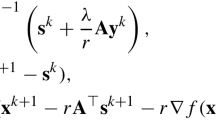Abstract
Interior point methods proved to be efficient and robust tools for solving large-scale optimization problems. The standard infeasible-start implementations scope very well with wide variety of problem classes, their only serious drawback is that they detect primal or dual infeasibility by divergence and not by convergence. As an alternative, approaches based on skew-symmetric and self-dual reformulations were proposed. In our computational study we overview the implementation of interior point methods on the homogeneous self-dual formulation of optimization problems and investigate the effect of the increased dimension from numerical and computational aspects.
Similar content being viewed by others
References
Andersen ED, Ye Y (1998) A computational study of the homogeneous algorithm for large-scale convex optimization. Comput Optim Appl 10:243–289
Andersen ED, Ye Y (1999) On a homogeneous algorithm for the monotone complementarity problem. Math Program 84(2):375–399
Andersen ED, Gondzio J, Meszaros C, Xu X (1996) Implementation of interior point methods for large scale linear programs. In: Terlaky T (ed) Interior point methods of mathematical programming. Kluwer, Dordrecht, pp 189–252
Anstreicher KM, Vial J-P (1994) On the convergence of an infeasible primal-dual interior-point method for convex programming. Optim Methods Softw 3:285–316
Gay DM (1985) Electronic mail distribution of linear programming test problems. COAL Newsl 13:10–12
Goldman AJ, Tucker AW (1956a) Polyhedral convex cones. In: Kuhn HW, Tucker AW (eds) Linear inequalities and related systems. Princeton University Press, Princeton, NJ, pp 19–40
Goldman AJ, Tucker AW (1956b) Theory of linear programming. In: Kuhn HW, Tucker AW (eds) Linear inequalities and related systems. Princeton University Press, Princeton, NJ, pp 53–97
Gondzio J (1996) Multiple centrality corrections in a primal-dual method for linear programming. Comput Optim Appl 6:137–156
Jansen B, Terlaky T, Roos C (1994) The theory of linear programming: skew symmetric self-dual problems and the central path. Optimization 29:225–233
Kojima M, Megiddo N, Mizuno S (1991) A primal-dual infeasible-interior-point algorithm for linear programming, Technical report
Kojima M, Megiddo N, Mizuno S (1993) A primal-dual infeasible-interior-point algorithm for linear programming. Math Program 61:263–280
Lustig IJ (1990) Feasibility issues in primal-dual interior-point methods for linear programming. Math Program 49:145–162
Lustig IJ, Marsten RE, Shanno DF (1992) On implementing Mehrotra’s predictor-corrector interior-point method for linear programming. SIAM J Optim 2(3):435–449
Lustig IJ, Marsten RE, Shanno DF (1994) Interior point methods for linear programming: computational state of the art. ORSA J Comput 6(1):1–15
Mehrotra S (1991) High order methods and their performance. Technical Report 90–16R1, Department of Industrial Engineering and Managment Sciences Northwestern University, Evanston, USA
Mészáros C (1997) On free variables in interior point methods. Optim Methods Softw 9:121–139
Mészáros C (1999) The BPMPD interior-point solver for convex quadratic problems. Optim Methods Softw 11 &12:431–449
Mészáros C (2005) On the Cholesky factorization in interior point methods. Comput Math Appl 50: 1157–1166
Mészáros C (2008) On numerical issues of interior point methods. SIAM J Matrix Anal 30(1):223–235
Mészáros C (2010) On the implementation of interior point methods for dual-core platforms. Optim Mathods Softw 25(3):449–456
Mészáros C (2011a) On sparse matrix orderings in interior point methods. Working paper, Computer and Automation Institute, Hungarian Academy of Sciences, Budapest
Mészáros C (2011b) Solving quadratically constrained convex optimization problems with an interior point method. Optim Methods Softw 26(3):421–429
Mészáros C (2012) Regularization techniques in interior point methods. J Comput Appl Math 236: 3704–3709
Mészáros C, Suhl UH (2004) Advanced preprocessing techniques for linear and quadratic programming. OR Spectrum 25:575–595
Mittelmann HD, Spellucci P (1998)Decision tree for optimization software. World Wide Web. http://plato.la.asu.edu/guide.html
Mizuno S (1994) Polynomiality of infeasible-interior-point algorithms for linear programming. Math Program 67(1):109–119
Mizuno S, Todd MJ (2001) On two homogeneous self-dual approaches to linear programming and its extensions. Math Program 89:517–534
Nesterov Y, Todd MJ, Ye Y (1999) Infeasible-start primal-dual methods and infeasibility detectors for nonlinear programming problems. Math Program 84:227–267
Tucker AW (1956) Dual systems of homogeneous linear relations. In: Kuhn HW, Tucker AW (eds) Linear inequalities and related systems. Princeton University Press, Princeton, NJ, pp 3–18
Vanderbei RJ (1995) Symmetric quasi-definite matrices. SIAM J Optim 5(1):100–113
Wolfe P (1961) A duality theorem for non-linear programming. Q Appl Math 19:239–244
Wright SJ (1999) Modified Cholesky factorizations in interior-point algorithms for linear programming. SIAM J Optim 9(4):1159–1191
Xu X (August 1994) An \({\cal O}(\sqrt{n} L)\)-iteration large-step infeasible path-following algorithm for linear programming. Technical report, College of Business Administration, The University of Iowa, Iowa City, IA 52242
Xu X (1996) On the implementation of a homogeneous and self-dual linear programming algorithm. Math Program 76(2):155–181
Xu X, Ye Y (1995) A generalized homogeneous and self-dual algorithm for linear programming. Oper Res Lett 17:181–190
Xu X, Hung P-F, Ye Y (1996) A simplified homogeneous and self-dual linear programming algorithm and its implementation. Ann Oper Res 62(1):151–171
Ye Y, Todd MJ, Mizuno S (1994) An \(O(\sqrt{n} L)\)-iteration homogeneous and self-dual linear programming algorithm. Math Oper Res 19:53–67
Author information
Authors and Affiliations
Corresponding author
Additional information
Supported in part by Hungarian Research Fund OTKA K-77420.
Rights and permissions
About this article
Cite this article
Meszaros, C. The practical behavior of the homogeneous self-dual formulations in interior point methods. Cent Eur J Oper Res 23, 913–924 (2015). https://doi.org/10.1007/s10100-013-0336-1
Published:
Issue Date:
DOI: https://doi.org/10.1007/s10100-013-0336-1




